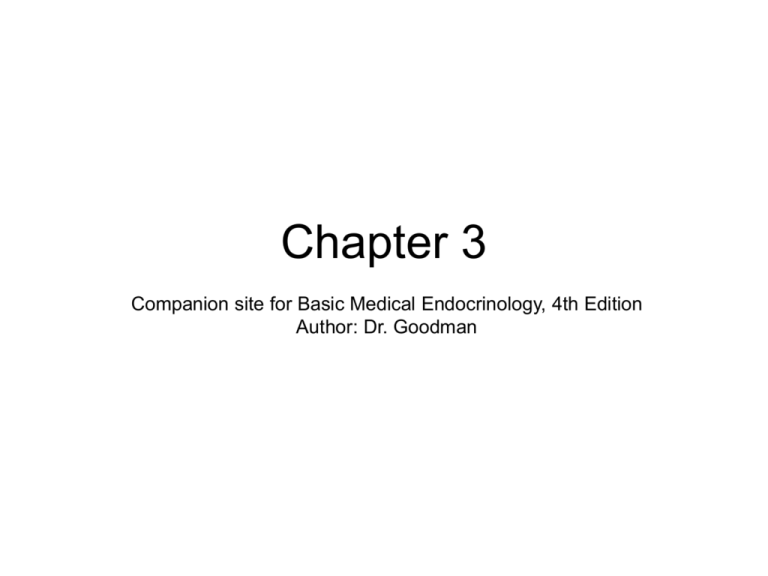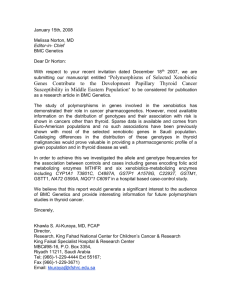
Chapter 3
Companion site for Basic Medical Endocrinology, 4th Edition
Author: Dr. Goodman
FIGURE 3.1
Gross anatomy of the thyroid gland. (From Netter, F.H. (1989) Atlas of Human Anatomy, 2nd Ed.
Novartis Summit New Jersey, Icon Learning Systems, LLC, a subsidiary of MediMedia, Inc,
Reprinted with permission from Icon Learning Systems, LLC, illustrated by Frank H. Netter, MD. All
rights reserved.)
Companion site for Basic Medical Endocrinology, 4th Edition. by Dr. Goodman
Copyright © 2009 by Academic Press. All rights reserved.
2
FIGURE 3.2
Low power photomicrograph of a rat thyroid gland. The thyroid follicles shown in cross section are
filled with uniformly staining colloid and are each composed of a single layer of epithelial cells (red
arrow). Note that the follicles are not uniform in size or shape. The white arrow points to a
parafollicular cell and the green arrow points to a connective tissue septum separating two lobules.
(Courtesy of Dr. William Cooke, Department of Cell Biology, University of Massachusetts Medical
School.)
Companion site for Basic Medical Endocrinology, 4th Edition. by Dr. Goodman
Copyright © 2009 by Academic Press. All rights reserved.
3
FIGURE 3.3
Thyroid hormones.
Companion site for Basic Medical Endocrinology, 4th Edition. by Dr. Goodman
Copyright © 2009 by Academic Press. All rights reserved.
4
FIGURE 3.4
Thyroid hormone biosynthesis and secretion. Iodide (I–) is transported into the thyroid follicular cell
by the sodium/iodide symporter (NIS) in the basal membrane and diffuses passively into the lumen
through the iodide channel called pendrin (P). Thyroglobulin (TG) is synthesized by microsomes on
the rough endoplasmic reticulum (ER), processed in the cisternae of the ER and the Golgi where it
is packaged into secretory granules and released into the follicular lumen. In the presence of
hydrogen peroxide (H2O2) produced in the luminal membrane by thyroid oxidase (TO), the thyroid
peroxidase (TPO) oxidizes iodide, which reacts with tyrosine residues in TG in the follicular lumen
to produce monoiodotyrosyl (MIT) and diiodotyrosyl (DIT) within the peptide chain. The TPO
reaction also catalyzes the coupling of iodotyrosines to form thyroxine (T4) and some
triiodothyronine (T3, not shown) within TG. Secretion of T4 begins with phagocytosis of TG, fusion
of TG-laden endosomes with lysosomes and proteolytic digestion to peptide fragments (PF), MIT,
DIT, and T4. T4 is released from the cell at the basal membrane. MIT and DIT are deiodinated by
iodotyrosine deiodinase (ITDI) and recycled.
Companion site for Basic Medical Endocrinology, 4th Edition. by Dr. Goodman
Copyright © 2009 by Academic Press. All rights reserved.
5
FIGURE 3.5
Hypothetical coupling scheme for intramolecular formation of T4 based on model reaction with
purified thyroid peroxidase. (Modified from Taurog, A. (2000) In Braverman, L.E. and Utiger, R.D.,
eds. Werner and Ingbar’s The Thyroid, 8th ed., p. 71. Lippincott Williams and Wilkins,
Philadelphia.)
Companion site for Basic Medical Endocrinology, 4th Edition. by Dr. Goodman
Copyright © 2009 by Academic Press. All rights reserved.
6
FIGURE 3.6
Scanning electron micrographs of the luminal microvilli of dog thyroid follicular cells. A. TSH
secretion suppressed by feeding thyroid hormone; magnification 36,000x. B. At 1 hr after TSH;
magnification 16,500x. (From Balasse, P.D., Rodesch, F.R., Neve, P.E. et al. (1972) Observations
en microscopie a balayage de la surface apicale y de cellules folliculares thyroidiennes chez le
chien. C. R. Acad. Sci. [D] (Paris), 274: 2332.) Hypothetical coupling scheme for intramolecular
formation of T4 based on model reaction with purified thyroid peroxidase. (Modified from Taurog, A.
(2000) In Braverman, L.E. and Utiger, R.D., eds. Werner and Ingbar’s The Thyroid, 8th ed., p. 71.
Lippincott Williams and Wilkins, Philadelphia.)
Companion site for Basic Medical Endocrinology, 4th Edition. by Dr. Goodman
Copyright © 2009 by Academic Press. All rights reserved.
7
FIGURE 3.7
Rate of loss of serum radioactivity after injection of labeled thyroxine or triiodothyronine into human
subjects. (Plotted from data of Nicoloff, J.D., Low, J. C., Dussault, J.H. et al. (1972) Simultaneous
measurement of thyroxine and triiodothyronine peripheral turnover kinetics in man. J. Clin. Invest.
51: 473.)
Companion site for Basic Medical Endocrinology, 4th Edition. by Dr. Goodman
Copyright © 2009 by Academic Press. All rights reserved.
8
FIGURE 3.8
Metabolism of thyroxine. About 90% of thyroxine is metabolized by sequential deiodination
catalyzed by deiodinases (types I, II, and III); the first step removes an iodine from either the
phenolic or tyrosyl ring producing an active (T3) or an inactive (rT3) compound. Subsequent
deiodinations continue until all the iodine is recovered from the thyronine nucleus. Green arrows
designate deiodination of the phenolic ring and red arrows indicate deiodination of the tyrosyl ring.
Less than 10% of thyroxine is metabolized by shortening the alanine side chain prior to
deiodination.
Companion site for Basic Medical Endocrinology, 4th Edition. by Dr. Goodman
Copyright © 2009 by Academic Press. All rights reserved.
9
FIGURE 3.9
Effects of thyroid therapy on growth and development of a child with no functional thyroid tissue.
Daily treatment with thyroid hormone began at 4.5 years of age (green arrow). Bone age rapidly
returned toward normal, and the rate of growth (height age) paralleled the normal curve. Mental
development, however, remained infantile. (From Wilkins, L. (1965) The Diagnosis and Treatment
of Endocrine Disorders in Childhood and Adolescence. Charles C Thomas, Springfield, Illinois.)
Companion site for Basic Medical Endocrinology, 4th Edition. by Dr. Goodman
Copyright © 2009 by Academic Press. All rights reserved.
10
FIGURE 3.10
Effects of thyroxine on oxygen consumption by various tissues of thyroidectomized rats. Note in A
the abscissa is in units of hours and in B the units are days. (Redrawn from Barker, S.B. and
Klitgaard, H.M. (1952) Metabolism of tissues excised from thyroxine-injected rats. Am. J. Physiol.
170: 81.)
Companion site for Basic Medical Endocrinology, 4th Edition. by Dr. Goodman
Copyright © 2009 by Academic Press. All rights reserved.
11
FIGURE 3.11
Effects of glucose and T3 on the induction of malic enzyme (ME) in isolated hepatocyte cultures.
Note that the amount of enzyme present in tissues was increased by growing cells in higher and
higher concentrations of glucose. Blue bars show effects of glucose in the presence of a low
(1010M) concentration of T3. Red bars indicate that the effects of glucose were exaggerated when
cells were grown in a high concentration of T3 (108M). (From Mariash, G.N. and Oppenheimer,
J.H. (1982) Thyroid hormone-carbohydrate interaction at the hepatic nuclear level. Fed. Proc. 41:
2674.)
Companion site for Basic Medical Endocrinology, 4th Edition. by Dr. Goodman
Copyright © 2009 by Academic Press. All rights reserved.
12
FIGURE 3.12
Feedback regulation of thyroid hormone secretion. Green arrow = stimulation. Red arrow =
inhibition.
Companion site for Basic Medical Endocrinology, 4th Edition. by Dr. Goodman
Copyright © 2009 by Academic Press. All rights reserved.
13
FIGURE 3.13
Effects of TRH, T3, and T4 on the thyrotrope. T3 downregulates expression of genes for TRH
receptors (TRHR) and both subunits of TSH (red arrows). TRH effects (shown in green) include
upregulation of TSH gene expression, enhanced TSH glycosylation, and accelerated secretion. TR
= thyroid hormone receptor.
Companion site for Basic Medical Endocrinology, 4th Edition. by Dr. Goodman
Copyright © 2009 by Academic Press. All rights reserved.
14
FIGURE 3.14
Effect of treatment of normal young men with thyroid hormones for 3 to 4 weeks on the response of
the pituitary to thyrotropin-releasing hormone (TRH) as measured by changes in plasma
concentrations of thyroid-stimulating hormone (TSH). The six subjects received 25 mg of TRH at
time 0 as indicated by the green arrow. Values are expressed as means SEM. (From Snyder, P.J.
and Utiger, R.D. (1972) Inhibition of thyrotropin response to thyrotropin-releasing hormone by small
quantities of thyroid hormones. J. Clin. Invest. 52: 2077.) Effect of treatment of normal young men
with thyroid
Companion site for Basic Medical Endocrinology, 4th Edition. by Dr. Goodman
Copyright © 2009 by Academic Press. All rights reserved.
15
FIGURE 3.15
Models of the effects of thyroid hormone receptor (TR) on gene transcription. A. In the absence of
T3 the TR in heterodimeric union with the retinoic acid receptor (RXR) binds to the thyroid hormone
response element (TRE) in DNA. The unliganded TR also binds to a corepressor, in this case the
silencing mediator retinoic acid and TR (SMRT), which recruits factors that remodel chromatin such
as histone deacetylase (HDAC), histone demethylase (HDM), histone methyl transferase (HMT)
and other factors that interfere with attachment of the RNA polymerase in the general transcription
complex to the TATA box in the promoter of a thyroid hormone regulated gene. B. Upon binding T3,
the TR changes its conformation, sheds the corepressor complex and replaces it with a coactivator,
in this case steroid receptor coactivator-1 (SRC-1), which recruits such chromatin remodeling
factors as histone acetylase (HA) and other coactivators that make the gene accessible to the
polymerase complex.Effect of treatment of normal young men with thyroid hormones for 3 to 4
weeks on the response of the pituitary to thyrotropin-releasing hormone (TRH) as measured by
changes in plasma concentrations of thyroid-stimulating hormone (TSH). The six subjects received
25 mg of TRH at time 0 as indicated by the green arrow. Values are expressed as means SEM.
(From Snyder, P.J. and Utiger, R.D. (1972) Inhibition of thyrotropin response to thyrotropin-releasing
hormone by small quantities of thyroid hormones. J. Clin. Invest. 52: 2077.) Effect of treatment of
normal young men with thyroid
Companion site for Basic Medical Endocrinology, 4th Edition. by Dr. Goodman
Copyright © 2009 by Academic Press. All rights reserved.
16







